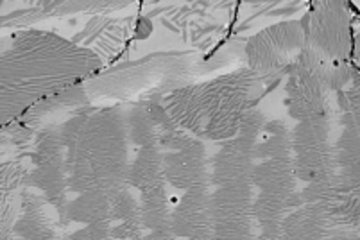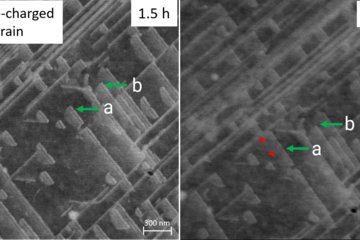All genres
21.
Journal Article
Atomic-resolution observations of silver segregation in a [111] tilt grain boundary in copper. Physical Review B 107 (13), 134112 (2023)
22.
Journal Article
Advancing strength and counteracting embrittlement by displacive transformation in heterogeneous high-entropy alloys containing sigma phase. Acta Materialia 246, 118717 (2023)
23.
Journal Article
Microstates and defects of incoherent Σ3 [111] twin boundaries in aluminum. Acta Materialia 243, 118499 (2023)
24.
Journal Article
Characterization of Compositionally Complex Hydrides in a Metastable Refractory High-Entropy Alloy. Acta Metallurgica Sinica (English Letters) 36 (6), pp. 1173 - 1178 (2023)
25.
Journal Article
Effect of Pore Formation on Redox-Driven Phase Transformation. Physical Review Letters 130, 168001 (2023)
26.
Journal Article
Microstructure, grain boundary evolution and anisotropic Fe segregation in (0001) textured Ti thin films. Acta Materialia 238, 118180 (2022)
27.
Journal Article
Reconstructing dual-phase nanometer scale grains within a pearlitic steel tip in 3D through 4D-scanning precession electron diffraction tomography and automated crystal orientation mapping. Ultramicroscopy 238, 113536 (2022)
28.
Journal Article
Free, flexible and fast: Orientation mapping using the multi-core and GPU-accelerated template matching capabilities in the Python-based open source 4D-STEM analysis toolbox Pyxem. Ultramicroscopy 237, 113517 (2022)
29.
Journal Article
Microstructure Evolution of a New Precipitation-Strengthened Fe–Al–Ni–Ti Alloy down to Atomic Scale. Metals 12 (6), 906 (2022)
30.
Journal Article
Revealing complex microstructure formation mechanisms in the Al20Cr20Fe35Ni20Ti5 compositionally complex alloy. Acta Materialia 229, 117739 (2022)
31.
Journal Article
Non-uniform He bubble formation in W/W2C composite: Experimental and ab-initio study. Acta Materialia 226, 117608 (2022)
32.
Journal Article
Quantitative analysis of grain boundary diffusion, segregation and precipitation at a sub-nanometer scale. Acta Materialia 225, 117522 (2022)
33.
Journal Article
Superior mechanical properties of a selective-laser-melted AlZnMgCuScZr alloy enabled by a tunable hierarchical microstructure and dual-nanoprecipitation. Materials Today 52, pp. 90 - 101 (2022)
34.
Journal Article
Strain rate dependent deformation behavior of BCC-structured Ti29Zr24Nb23Hf24 high entropy alloy at elevated temperatures. Journal of Alloys and Compounds 891, 161859 (2022)
35.
Journal Article
Dual phase patterning during a congruent grain boundary phase transition in elemental copper. Nature Communications 13 (1), 3331 (2022)
36.
Journal Article
Segmentation of Static and Dynamic Atomic-Resolution Microscopy Data Sets with Unsupervised Machine Learning Using Local Symmetry Descriptors. Microscopy and Microanalysis 27 (6), pp. 1454 - 1464 (2021)
37.
Journal Article
Substitutional synthesis of sub-nanometer InGaN/GaN quantum wells with high indium content. Scientific Reports 11 (1), 20606 (2021)
38.
Journal Article
Aluminum depletion induced by co-segregation of carbon and boron in a bcc-iron grain boundary. Nature Communications 12, 6008 (2021)
39.
Journal Article
Influence of substrates and e-beam evaporation parameters on the microstructure of nanocrystalline and epitaxially grown Ti thin films. Applied Surface Science 562, 150194 (2021)
40.
Journal Article
Enhanced thermal stability of (Ti,Al)N coatings by oxygen incorporation. Acta Materialia 218, 117204 (2021)











